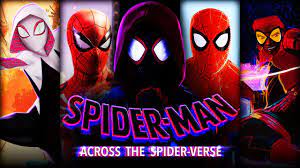 By Andrew Jenck
By Andrew Jenck
Given the creative stagnation of modern blockbusters, it’s still unbelievable that a Spider-Man film could be innovative, as Into the Spider-Verse ushered a new wave of stylized animation and converted so many parts into a cohesive narrative. The filmmakers had full faith in the different webslinger of Miles Morales by giving him unique visualization, humor, and subject matter often not found in other Marvel adaptations. A successor was always going to approach pitfalls that have befallen other superhero sequels: expanding the scope and diving more into the characters’ lore can result in convoluted scripts. As with last time, however, the writers know to have everything either tie back to, or parallel, Mile’s journey, offering yet another ambitious story worthy of the stunning visuals. Across the Spider-Verse, although less well-rounded, dives even further into the character’s ethos as much as the multiverse, enriched with strong themes of parenthood and going against the grain; a celebration of the character, its impact while self-aware of it being a conglomerate.
After establishing that “anyone can wear the mask,” Across states that no one has to be bound by a set of guidelines. Feeling forced in certain directions by his parents and the angsty Spidey Miguel O’Hara, he feels he is being restricted to paths that don’t allow for him to be his best self. Even his closest friends, like Gwen and Peter B., allow themselves to follow orders that don’t sit well with them. A metacommentary regarding the brand’s stagnation is at play here with canon being a sacred law, not unlike fans or Marvel Comics that cling on with an iron grip. Miles is told that he needs to let certain events transpire, despite being against the very essence of his heroic duties and that of Spider-Man in general. Online discourse focused on Miles tends to demean him as ill fit for the persona, refusing to call him Spider-Man out of racial hate. O’Hara especially encompasses the animosity towards Miles, not due to racism but woven in well to the narrative, making sense even without outside knowledge.
As with most second chapters, the film adds complexities into the mix, symbolizing Miles approaching the messy world that is adulthood. Gwen has a larger role, showing more parallels to Miles’ life, particularly with their parental relations and secret identities as Parenting is a major theme, shown at different stages and having the anxiety of raising their kid. The Morales’ and Capt. Stacy’s current methods aren’t getting to their children, and in need of changing their approaches. Peter B. meanwhile is at the start of parenthood, needing reassurance but can never attain set guidelines. These character arcs form a more complete picture where other films may lean into one side, strengthening a narrative to live up to the stunning animation.
The visual storytelling is outstanding, a clear love for the comics translated through gorgeous animation. Gwen’s universe will change color pallets along with her emotions, just one example of visualizing the characters’ psyche. There’s a lot of fun in translating the comics’ material, while still feeling fluid. The set pieces are frenetic but boarded well that you see the carefully crafted details. It goes from slapstick to impactful visuals. There’s a lot more Spider-People here, character movements were crucial to distinguish them. You get a feel for everyone’s Earth and personality, even if they appear for just a few seconds. This is thanks to great character animation by the artists and the vocal talent, all of whom make the performance in a cartoon. Spider-Punk especially stands out, looking like a collage of rock n roll magazines; unlike other multiverse films that just remind the audience of IPs. Special mention to Daniel Pemberton and the various rap artists led by Metro Boomin who match the beats greatly with their respective scenes, working congruently with the set pieces.
A few flaws exist, albeit minor. The mentor-student dynamic between Gwen and the pregnant Jess could’ve used an extended scene. Music again is phenomenal but is closer-tied to the film and has less variety, coming from just a few artists. All the universes are incredibly designed, but the ones given the most focus could’ve used some more visual flourishes in the background, especially compared to the more unique ones. Although the experience is satisfying, there are a few loose threads to be tied in a later installment, so narratively, it can’t be as well-rounded as the first film. It will leave you wanting more but in a good way.
Spider-Man: Across the Spider-Verse is another triumph of filmmaking, made even more impressive that a mainline film could be bold and experimental in a time where a by-the-numbers approach has been all encompassing. The scope is large, but the story still feels personal. Beaming of artistry, the animation and designs of characters and settings demand to be seen in theaters. Even audiences who have grown tired of the current superhero formula will be impressed. The writing transcends its peers while fully embracing its comic book roots, making for one of the most earnest, against-the-grain films in recent years, just like the spirit of Spidey.


